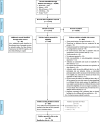Enablers and barriers to physical activity among older adults of low socio-economic status: a systematic review of qualitative literature
- PMID: 40545546
- PMCID: PMC12183869
- DOI: 10.1186/s12966-025-01753-4
Enablers and barriers to physical activity among older adults of low socio-economic status: a systematic review of qualitative literature
Abstract
Background: Understanding the factors influencing physical activity in older adults, and whether they vary according to socio-economic status (SES), could help to inform interventions that are effective in reducing inequalities and improving the quality of life of an ageing population. This systematic review aimed to synthesise the qualitative evidence on the modifiable enablers of, and barriers to, physical activity based on low-SES older adults' perspectives in the United Kingdom (UK). A secondary aim was to identify and summarise differences in physical activity enablers and barriers between older adults of low and high SES.
Methods: We searched five electronic databases from inception to December 2023 for studies conducted among UK-based, community-dwelling older adults aged 60+ years including qualitative methods, with results reported by SES. We excluded hospitalised or institutionalised participants. Risk of bias was assessed with the Mixed Methods Appraisal Tool, and framework synthesis was applied using the Capability, Opportunity, Motivation, and Behaviour (COM-B) model.
Results: Thirty studies were included in the review, of which five specifically examined inequalities in physical activity enablers and barriers. Low-SES older adults' physical capability was influenced by fitness, mobility, and general health, while their psychological capability was shaped by knowledge and behavioural regulation. Physical opportunity was characterised by safety, pedestrian infrastructure, access to physical activity opportunities and daily destinations, environmental quality, and aesthetics. Themes under social opportunity encompassed social support, social norms, social engagement, and dog ownership. Physical activity was motivated by reflective processes, such as outcome expectancies, self-efficacy, and attitudes, as well as automatic processes, including habits, lack of time, and enjoyment. Few studies investigated differences between participants of low and high SES, with those that did predominantly pointing to disparities in the physical or built environment.
Conclusions: This meta-synthesis of qualitative literature identified a wide range of interacting factors influencing physical activity across socio-ecological and COM-B domains, underscoring whole-system interventions as a potential approach to stimulate meaningful and sustained change. Future research could report results by SES to enhance our understanding of inequalities and ensure that low-SES older adults are represented in the development and evaluation of interventions targeting improvements in physical activity.
Keywords: Health inequalities; Older adults; Physical activity; Qualitative research; Socio-economic status; Systematic review.
© 2025. The Author(s).
Conflict of interest statement
Declarations. Ethics approval and consent to participate: This study was approved by the Research Ethics Approval Committee for Health [EP 23 010] at the University of Bath. This study did not involve the collection of primary data involving human participants; informed consent was therefore not applicable. Consent for publication: Not applicable. Competing interests: The authors declare no competing interests.
Figures



References
-
- Cunningham C, O’Sullivan R, Caserotti P, Tully MA. Consequences of physical inactivity in older adults: a systematic review of reviews and meta-analyses. Scand J Med Sci Sports. 2020;30:816–27. - PubMed
-
- NHS Digital. part 2. Leeds: NHS Digital; 2021. p. 2023.
-
- Farrell L, Hollingsworth B, Propper C, Shields MA. The socioeconomic gradient in physical inactivity: evidence from one million adults in England. Soc Sci Med. 2014;123:55–63. - PubMed
Publication types
MeSH terms
Grants and funding
LinkOut - more resources
Full Text Sources
Medical

